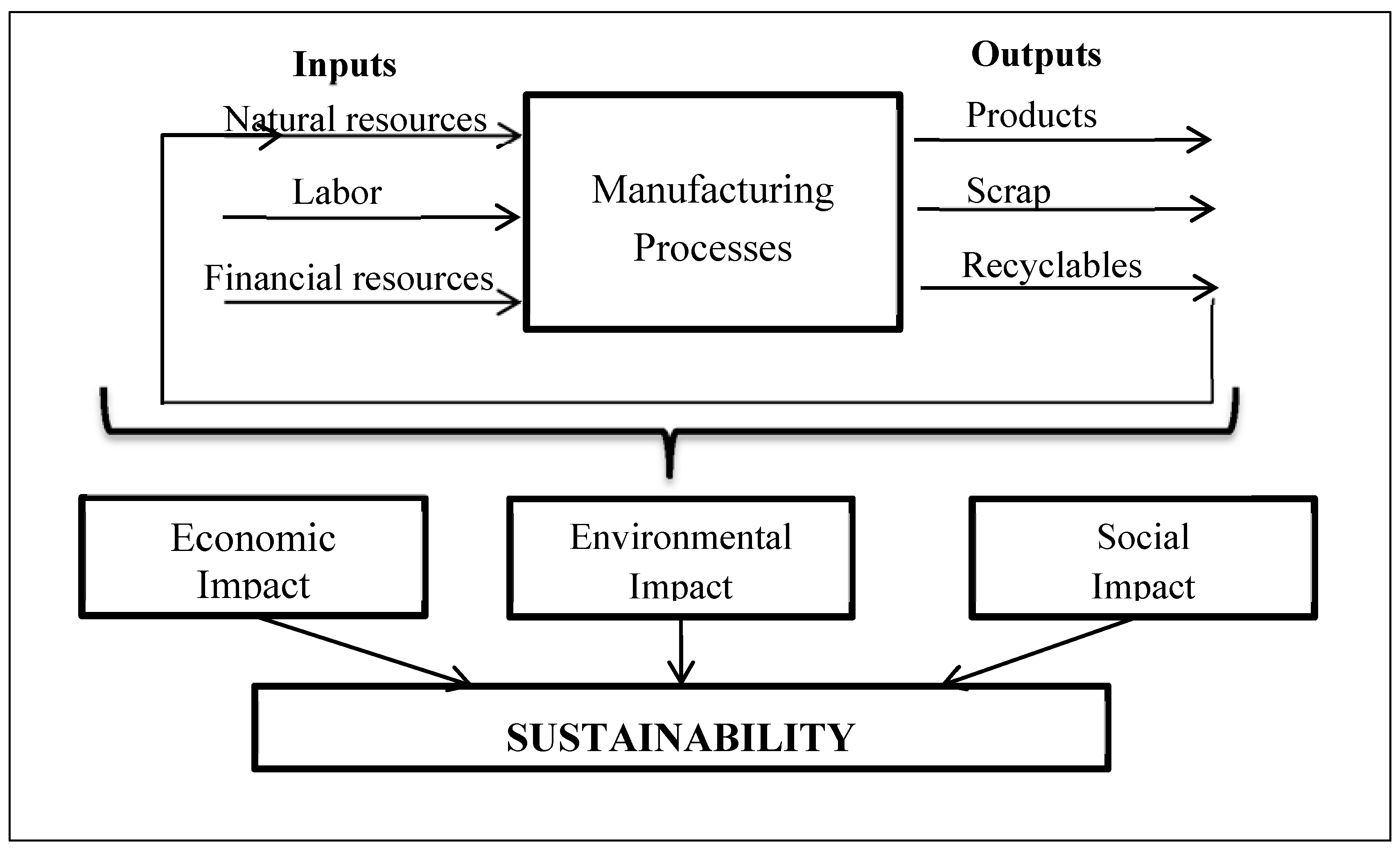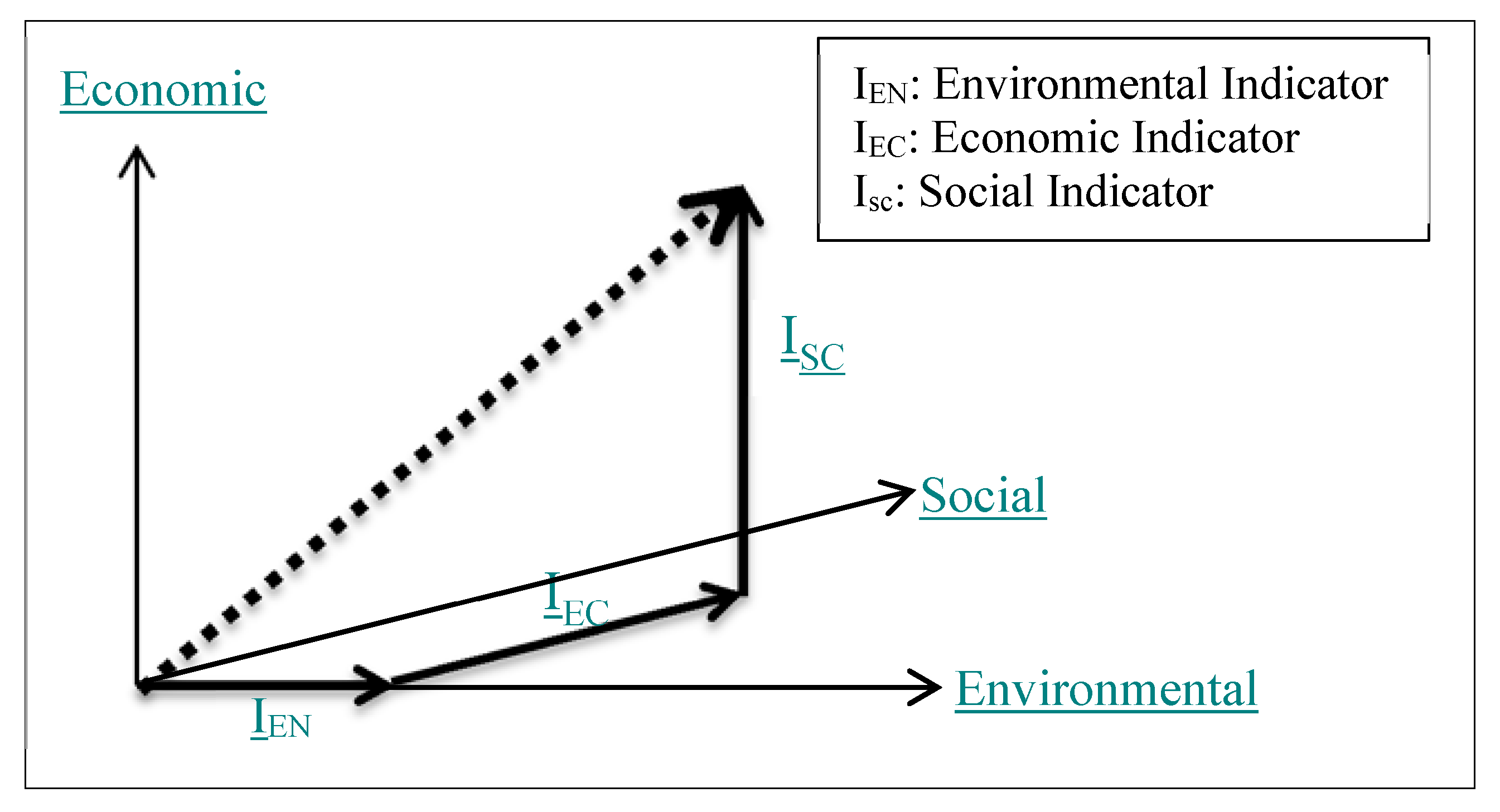A Mathematical Programming Approach to the Optimal Sustainable Product Mix for the Process Industry
Abstract
:1. Introduction
2. Literature Review
3. Mathematical Model Development
3.1. Problem Definition

3.2. Mathematical Model
3.2.1. Model Assumptions
- Only one type of emissions is considered, which is CO2.
- Demand is deterministic and constant.
- Exact amounts of raw material required for producing each product type and CO2 emissions resulting from the production are known.

3.2.2. Model Nomenclature
| i | Elements of the first hierarchy level of environmental indicators |
| j | Elements of the second hierarchy level in environmental indicators |
| k | Product type, k = 1, …, N |
| l | Elements of the first hierarchy level in economic and social indicators |
| p | Input type |
| m | Hazardous material type |
| MHk | Man-hours/unit weight of product k |
| N | Number of products |
| βk | Ratio of recyclable products |
| δmk | Amount of hazardous material m in product k (kg) |
| RT | Available regular time (h) |
| Wk | Amount of water consumed per unit weight of product k (m3/kg) |
| WWk | Amount of waste water per unit weight of product k (m3/kg) |
| QCk | Amount of CO2 generated in the production of the unit weight of product k |
| cp1 | Amount of emissions resulting from one kWh of electricity generated from conventional generation (kg CO2/kWh) |
| cp2 | Amount of emissions resulting from the transportation of the unit weight per unit distance (kg CO2/tkm) |
| λk | Percentage of defects of product k |
| Dk | Demand for product k (kg) |
| ek | Amount of energy consumed in producing a unit weight of product k (kWh/kg) |
| Emin | Minimum allowable percentage of renewable energy used (%) |
| Emax | Maximum percentage of renewable energy used (%) |
| B | Available working capital (Egyptian Pound (EGP); 1EGP=0.13 USD) |
| Ce | Cost of 1 kWh of electricity via renewable resources (EGP/kWh) |
| Cc | Price of electricity purchased from the grid (EGP/kWh) |
| qpk | Quantity of input type p in product k (kg/kg) |
| cp | Unit cost of input type p (EGP/kg) |
| pk | Selling price of the unit weight of product k (EGP/kg) |
| dk | Transportation distance of product k (km) |
| Q | The maximum possible number of diversified products in the considered industry |
| M | Total manpower |
| fk | Product fraction |
| El | Labor rate for regular time (EGP/worker hour) |
| Eo | Labor rate for over time (EGP/worker hour) |
| Hm | Maximum permissible amount of hazardous material of type m to include (kg) |
| Ovmax | Maximum allowed overtime expressed as a percentage of regular time (%) |
| Btmin | Minimum training budget (EGP) |
| W1ij | Weight of sub-indicator i of the j-th element in first hierarchal level of the environmental indicators |
| W2l | Weight of the l-th element of economic indicators |
| W3l | Weight of the l-th element of social indicators |
| Bt | Training budget (EGP) |
| xk | Amount produced from product k (kg) |
| er | Renewable energy used expressed as the percentage of total energy necessary to produce a unit weight of product (%) |
| rk | Amount of product k to be recycled (kg) |
| sk | Amount of product k to be scrapped (kg) |
| Ov | Amount of overtime needed (h) |
3.2.3. Objective Function

3.2.4. Constraints
3.3. Numerical Illustration
| Parameter | Value | Units | Parameter | Value | Units | Parameter | Value | Units |
|---|---|---|---|---|---|---|---|---|
| MHk | 0.02288 0.00763 0.00572 | h/kg | pk | 358.30 139.30 114.00 | EGP | dk | 100 200 400 | km |
| δmk | 0.0014 × 10−3 0.0007 × 10−3 0.0014 × 10−3 | kg | QCk | 9.518 × 10−6 4.759 × 10−5 1.904 × 10−5 | kg CO2/kg | Dk | 1000 1000 1000 | ton |
| Wk | 0.2473 0.4946 0.4122 | m3 | qpk | 0.1 0.2 0.1 0.2 0.3 0.8 0.7 0.5 0.5; | kg/kg | cp | 0.300 0.233 0.637 | EGP/kg |
| WWk | 0.0393 0.0196 0.0131 | m3 | 25.5×10−3 8.5×10−3 6.4×10−3 | kWh/kg | Eo | 36.75 | EGP/h | |
| El | 24.5 | EGP/h | ||||||
| B | 8,629,140 | EGP | Ce | 1.2 | EGP/kWh | Emin | 2 | % |
| RT | 2400 | h | - | - | - | Emax | 7 | % |
| 30 | % | cp2 | 3.041 × 10−3 | kg CO2/kgkm | Hm | 20 | kg | |
| λk | 0.07 | % | cp1 | 6.648 × 10−4 | kg CO2/kWh | Q | 12 | - |
| - | - | - | Cc | 0.75 | EGP/kWh | M | 50 | worker |
| βk | 0.36 | % | Btmin | 0.0025 × B | EGP | N | 3 | - |
| Environmental Indicators | Economic Indicators | ||
|---|---|---|---|
| Indicator | Weight | Indicator | Weight |
| I111 | 0.013 | I21 | 0.583 |
| I112 | 0.004 | I22 | 0.141 |
| I123 | 0.053 | I23 | 0.056 |
| I132 | 0.002 | Social Indicators | |
| I133 | 0.007 | Indicator | Weight |
| I134 | 0.001 | I32 | 0.015 |
| I141 | 0.035 | I33 | 0.062 |
| I142 | 0.004 | I34 | 0.006 |
| Indicator | Environmental | Economic | Social | Weight |
|---|---|---|---|---|
| Environmental | 1 | 1/7 | 2 | 0.13738 |
| Economic | 7 | 1 | 8 | 0.77984 |
| Social | 1/2 | 1/8 | 1 | 0.08277 |
4. Results and Discussion
| Variable | Value | Units |
|---|---|---|
| Bt | 21,572.85 | (EGP) |
| xk | 13,246.48; 2078.47; 0 | (kg) |
| Ov | 0 | (h) |
| z0 | 0 | - |
| er | 0.007 | (%) |
| rk | 278.18; 43.65; 0 | (kg) |
| sk | 649.1; 101.8; 0 | (kg) |
| SI | 0.5083 | - |
| Environmental Indicators | Economic Indicators | ||
|---|---|---|---|
| Indicator | Value | Indicator | Value |
| I111 | 0.007 | I21 | 0.41 |
| I112 | 0.998 | I22 | 0.93 |
| I123 | 0.870 | I23 | 0.160 |
| I132 | 0.021 | Social Indicators | |
| I133 | 0.9999 | Indicator | Value |
| I134 | 0.9951 | I32 | 0.007 |
| I141 | 0.999 | I33 | 1 |
| I142 | 0.000 | I34 | 0.990 |

| Variable | Value | Units |
|---|---|---|
| Bt | 21,572.85 | (EGP) |
| xk | 9347.1; 6108.5; 1884.3 | (kg) |
| Ov | 0 | (h) |
| z0 | 0 | |
| er | 0.002 | (%) |
| rk | 0; 0; 0 | (kg) |
| sk | 654.3; 427.6; 131.9 | (kg) |
| SI | 0.46742 | - |
5. Conclusions
Acknowledgments
Author Contributions
Conflicts of Interest
References
- How Does Commerce Define Sustainable Manufacturing? Available online: http://www.trade.gov/competitiveness/sustainablemanufacturing/how_doc_defines_SM.asp (accessed on 25 December 2014).
- Glavič, P.; Lukman, R. Review of sustainability terms and their definitions. J. Clean. Prod. 2007, 15, 1875–1885. [Google Scholar] [CrossRef]
- Jovane, F.; Yoshikawa, H.; Alting, L.; Boër, C.R.; Westkamper, E.; Williams, D.; Tseng, M.; Seliger, G.; Paci, A.M. The incoming global technological and industrial revolution towards competitive sustainable manufacturing. CIRP Ann. Manuf. Technol. 2008, 57, 641–659. [Google Scholar] [CrossRef]
- Rosen, M.A.; Kishawy, H.A. Sustainable manufacturing and design: Concepts, practices and needs. Sustainability 2012, 4, 154–174. [Google Scholar] [CrossRef]
- Bi, Z. Revisiting system paradigms from the viewpoint of manufacturing sustainability. Sustainability 2011, 3, 1323–1340. [Google Scholar] [CrossRef]
- Chen, D.; Schudeleit, T.; Posselt, G.; Thiede, S. A state-of-the-art review and evaluation of tools for factory sustainability assessment. Procedia CIRP 2013, 9, 85–90. [Google Scholar] [CrossRef]
- Joung, C.B.; Carrell, J.; Sarkar, P.; Feng, S.C. Categorization of indicators for sustainable manufacturing. Ecol. Indic. 2013, 24, 148–157. [Google Scholar] [CrossRef]
- Letmathe, P.; Balakrishnan, N. Environmental considerations on the optimal product mix. Eur. J. Oper. Res. 2005, 167, 398–412. [Google Scholar] [CrossRef]
- Rǎdulescu, M.; Rǎdulescu, S.; Rǎdulescu, C.Z. Sustainable production technologies which take into account environmental constraints. Eur. J. Oper. Res. 2009, 193, 730–740. [Google Scholar] [CrossRef]
- Tsai, W.-H.; Lin, W.-R.; Fan, Y.-W.; Lee, P.-L.; Lin, S.-J.; Hsu, J.-L. Applying a mathematical programming approach for a green product mix decision. Int. J. Prod. Res. 2012, 50, 1171–1184. [Google Scholar] [CrossRef]
- Tsai, W.-H.; Chen, H.-C.; Leu, J.-D.; Chang, Y.-C.; Lin, T.W. A product-mix decision model using green manufacturing technologies under activity-based costing. J. Clean. Prod. 2013, 57, 178–187. [Google Scholar] [CrossRef]
- Yuan, C.; Zhai, Q.; Dornfeld, D. A three dimensional system approach for environmentally sustainable manufacturing. CIRP Ann. Manuf. Technol. 2012, 61, 39–42. [Google Scholar] [CrossRef]
- OECD Sustainable Manufacturing Toolkit. Avalable online: http://www.oecd.org/sti/inno/48101937.pdf (accessed on 25 December 2014).
- Samuel, V.B.; Agamuthu, P.; Hashim, M.A. Indicators for assessment of sustainable production: A case study of the petrochemical industry in Malaysia. Ecol. Indic. 2013, 24, 392–402. [Google Scholar] [CrossRef]
- Chen, D.; Thiede, S.; Schudeleit, T.; Herrmann, C. A holistic and rapid sustainability assessment tool for manufacturing SMEs. CIRP Ann. Manuf. Technol. 2014, 63, 437–440. [Google Scholar] [CrossRef]
- Jayal, A.D.; Badurdeen, F.; Dillon, O.W.; Jawahir, I.S. Sustainable manufacturing: modeling and optimization challenges at the product, process and system levels. CIRP J. Manuf. Sci. Technol. 2010, 2, 144–152. [Google Scholar] [CrossRef]
- Al-Sharrah, G.; Elkamel, A.; Almanssoor, A. Sustainability indicators for decision-making and optimisation in the process industry: The case of the petrochemical industry. Chem. Eng. Sci. 2010, 65, 1452–1461. [Google Scholar] [CrossRef]
- Vimal, K.E.K.; Vinodh, S.; Raja, A. Modelling, assessment and deployment of strategies for ensuring sustainable shielded metal arc welding process—A case study. J. Clean. Prod. 2015, 93, 364–377. [Google Scholar] [CrossRef]
- Sustainable Manufacturing Indicators. Available online: http://gccbs2013.aast.edu/newgcc/images/pdf/sustainable%20manufacturing%20indicators.pdf (accessed on 25 December 2014).
- Park, K.; Jang, S.S. Effect of diversification on firm performance: Application of the entropy measure. Int. J. Hosp. Manag. 2012, 31, 218–228. [Google Scholar] [CrossRef]
- Saaty, T.L. Decision making with the analytic hierarchy process. Int. J. Serv. Sci. 2008, 1, 83–98. [Google Scholar] [CrossRef]
© 2015 by the authors; licensee MDPI, Basel, Switzerland. This article is an open access article distributed under the terms and conditions of the Creative Commons Attribution license (http://creativecommons.org/licenses/by/4.0/).
Share and Cite
Galal, N.M.; Moneim, A.F.A. A Mathematical Programming Approach to the Optimal Sustainable Product Mix for the Process Industry. Sustainability 2015, 7, 13085-13103. https://doi.org/10.3390/su71013085
Galal NM, Moneim AFA. A Mathematical Programming Approach to the Optimal Sustainable Product Mix for the Process Industry. Sustainability. 2015; 7(10):13085-13103. https://doi.org/10.3390/su71013085
Chicago/Turabian StyleGalal, Noha M., and Ahmed F. Abdul Moneim. 2015. "A Mathematical Programming Approach to the Optimal Sustainable Product Mix for the Process Industry" Sustainability 7, no. 10: 13085-13103. https://doi.org/10.3390/su71013085





